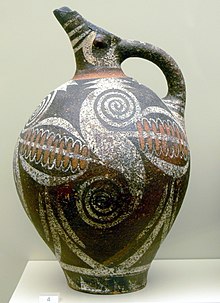Minoan art
Art produced by the Minoan civilization / From Wikipedia, the free encyclopedia
Dear Wikiwand AI, let's keep it short by simply answering these key questions:
Can you list the top facts and stats about Minoan art?
Summarize this article for a 10 years old
Minoan art is the art produced by the Bronze Age Aegean Minoan civilization from about 3000 to 1100 BC, though the most extensive and finest survivals come from approximately 2300 to 1400 BC. It forms part of the wider grouping of Aegean art, and in later periods came for a time to have a dominant influence over Cycladic art. Since wood and textiles have decomposed, the best-preserved (and most instructive) surviving examples of Minoan art are its pottery, palace architecture (with frescos which include "the earliest pure landscapes anywhere"),[3] small sculptures in various materials, jewellery, metal vessels, and intricately-carved seals.

| 3500–2900 BC[2] | EMI | Prepalatial |
| 2900–2300 BC | EMII | |
| 2300–2100 BC | EMIII | |
| 2100–1900 BC | MMIA | |
| 1900–1800 BC | MMIB | Protopalatial (Old Palace Period) |
| 1800–1750 BC | MMIIA | |
| 1750–1700 BC | MMIIB | Neopalatial (New Palace Period) |
| 1700–1650 BC | MMIIIA | |
| 1650–1600 BC | MMIIIB | |
| 1600–1500 BC | LMIA | |
| 1500–1450 BC | LMIB | Postpalatial (at Knossos; Final Palace Period) |
| 1450–1400 BC | LMII | |
| 1400–1350 BC | LMIIIA | |
| 1350–1100 BC | LMIIIB |
It was influenced by the neighbouring cultures of Ancient Egypt and the ancient Near East, which had produced sophisticated urban art for much longer, but the character of the small but wealthy mercantile Minoan cities was very different, with little evidence of large temple-based religion, monarchs, or warfare, and "all the imaginative power and childlike freshness of a very young culture".[4] All these aspects of the Minoan culture remain rather mysterious. Sinclair Hood described an "essential quality of the finest Minoan art, the ability to create an atmosphere of movement and life although following a set of highly formal conventions".[5]
The largest and best collection of Minoan art is in the Heraklion Archaeological Museum ("AMH") near Knossos, on the northern coast of Crete. Minoan art and other remnants of material culture, especially the sequence of ceramic styles, have been used by archaeologists to define the three main phases of Minoan culture (EM, MM, LM), and their many sub-phases. The dates to be attached to these remain much discussed, although within narrowing ranges.[6]
The relationship of Minoan art to that of other contemporary cultures and later Ancient Greek art has been much discussed. It clearly dominated Mycenaean art and Cycladic art of the same periods,[7] even after Crete was occupied by the Mycenaeans, but only some aspects of the tradition survived the Greek Dark Ages after the collapse of Mycenaean Greece.[8]